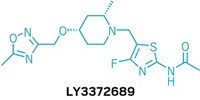Advertisement
Grab your lab coat. Let's get started
Welcome!
Welcome!
Create an account below to get 6 C&EN articles per month, receive newsletters and more - all free.
It seems this is your first time logging in online. Please enter the following information to continue.
As an ACS member you automatically get access to this site. All we need is few more details to create your reading experience.
Not you? Sign in with a different account.
Not you? Sign in with a different account.
ERROR 1
ERROR 1
ERROR 2
ERROR 2
ERROR 2
ERROR 2
ERROR 2
Password and Confirm password must match.
If you have an ACS member number, please enter it here so we can link this account to your membership. (optional)
ERROR 2
ACS values your privacy. By submitting your information, you are gaining access to C&EN and subscribing to our weekly newsletter. We use the information you provide to make your reading experience better, and we will never sell your data to third party members.
Pharmaceuticals
GSK2636771 - GlaxoSmithKline
Medicinal chemists debut five drug candidates and describe their discovery.
by Carmen Drahl
April 16, 2012
| A version of this story appeared in
Volume 90, Issue 16

Ralph A. Rivero, a medicinal chemistry director at GlaxoSmithKline in Collegeville, Pa., disclosed the structure of GSK2636771, an experimental drug designed to treat cancer patients whose tumor tissue has greatly reduced amounts of a tumor suppressor called phosphatase and tensin homolog (PTEN). PTEN “is the second most inactivated tumor suppressor in cancers after p53,” Rivero said in San Diego. The cancers where PTEN loss is frequently involved include prostate and endometrial cancers, and melanoma.
Currently, no cancer treatments on the market tackle PTEN-deficient tumors specifically. When GSK started its PTEN project, multiple experiments in cancer cell lines suggested that growth in tumors with PTEN inactivation was largely driven by the β isoform of phosphatidylinositol-3 kinase (PI3K). In those days, most firms were focusing on blocking either all the PI3K isoforms at once or PI3K’s α isoform, for a variety of applications, Rivero told C&EN. “We saw the data as an opportunity to develop a PI3Kβ-selective agent,” he said. Such an agent might not have the side effects associated with pan-PI3K inhibition, such as rashes.
The company started with TGX-221, a PI3Kβ-selective compound published by Australian researchers in 2005 (Nat. Med., DOI: 10.1038/nm1232). With TGX-221, the team developed a model for PI3Kβ binding and selectivity in which the molecule’s morpholine ring was important for binding to the enzyme’s hinge region, whereas its carbonyl group was critical for binding to the enzyme’s back pocket, among other things. As the medicinal chemistry team progressed, it seemed boxed in, because promising inhibitors were quickly cleared from the body in three out of four animals used in preclinical testing. The breakthrough happened when it turned out that a carbonyl group on the central ring that they thought was critical for interacting with the back pocket of PI3Kβ wasn’t so critical after all. When they realized they could move the group out from the ring and replace it with a variety of functional groups such as a carboxylic acid, GSK2636771 eventually emerged. The compound, which is designed to be taken orally once a day, is currently in Phase I clinical trials, which are designed to evaluate its pharmacokinetics and safety in people with PTEN-deficient tumors.






Join the conversation
Contact the reporter
Submit a Letter to the Editor for publication
Engage with us on Twitter